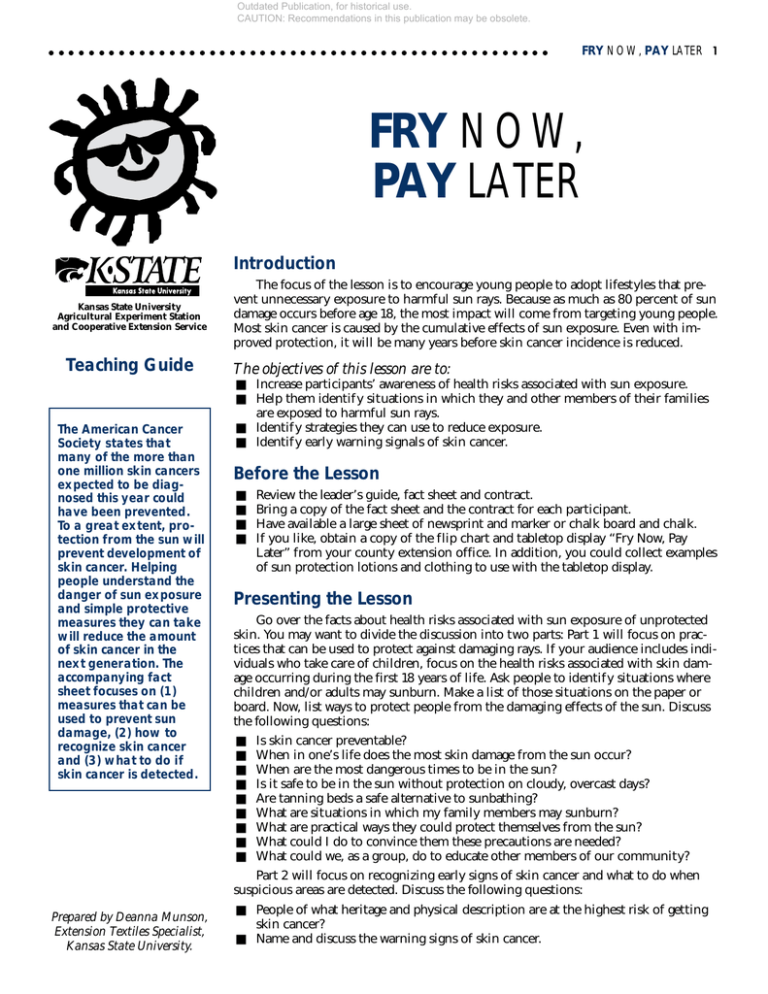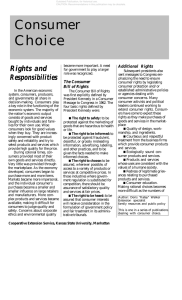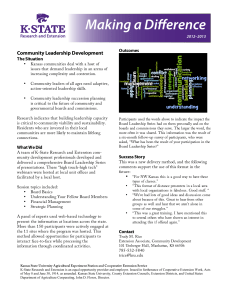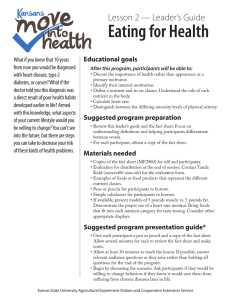
Outdated Publication, for historical use.
CAUTION: Recommendations in this publication may be obsolete.
○ ○ ○ ○ ○ ○ ○ ○ ○ ○ ○ ○ ○ ○ ○ ○ ○ ○ ○ ○ ○ ○ ○ ○ ○ ○ ○ ○ ○ ○ ○ ○ ○ ○ ○ ○ ○ ○ ○ ○ ○ ○ ○ ○ ○ ○ ○ ○ ○ ○
FRY NOW, PAY LATER 1
FRY NOW,
PAY LATER
Introduction
Kansas State University
Agricultural Experiment Station
and Cooperative Extension Service
Teaching Guide
The American Cancer
Society states that
many of the more than
one million skin cancers
expected to be diagnosed this year could
have been prevented.
To a great extent, protection from the sun will
prevent development of
skin cancer. Helping
people understand the
danger of sun exposure
and simple protective
measures they can take
will reduce the amount
of skin cancer in the
next generation. The
accompanying fact
sheet focuses on (1)
measures that can be
used to prevent sun
damage, (2) how to
recognize skin cancer
and (3) what to do if
skin cancer is detected.
The focus of the lesson is to encourage young people to adopt lifestyles that prevent unnecessary exposure to harmful sun rays. Because as much as 80 percent of sun
damage occurs before age 18, the most impact will come from targeting young people.
Most skin cancer is caused by the cumulative effects of sun exposure. Even with improved protection, it will be many years before skin cancer incidence is reduced.
The objectives of this lesson are to:
■ Increase participants’ awareness of health risks associated with sun exposure.
■ Help them identify situations in which they and other members of their families
are exposed to harmful sun rays.
■ Identify strategies they can use to reduce exposure.
■ Identify early warning signals of skin cancer.
Before the Lesson
■
■
■
■
Review the leader’s guide, fact sheet and contract.
Bring a copy of the fact sheet and the contract for each participant.
Have available a large sheet of newsprint and marker or chalk board and chalk.
If you like, obtain a copy of the flip chart and tabletop display “Fry Now, Pay
Later” from your county extension office. In addition, you could collect examples
of sun protection lotions and clothing to use with the tabletop display.
Presenting the Lesson
Go over the facts about health risks associated with sun exposure of unprotected
skin. You may want to divide the discussion into two parts: Part 1 will focus on practices that can be used to protect against damaging rays. If your audience includes individuals who take care of children, focus on the health risks associated with skin damage occurring during the first 18 years of life. Ask people to identify situations where
children and/or adults may sunburn. Make a list of those situations on the paper or
board. Now, list ways to protect people from the damaging effects of the sun. Discuss
the following questions:
■
■
■
■
■
■
■
■
■
Is skin cancer preventable?
When in one’s life does the most skin damage from the sun occur?
When are the most dangerous times to be in the sun?
Is it safe to be in the sun without protection on cloudy, overcast days?
Are tanning beds a safe alternative to sunbathing?
What are situations in which my family members may sunburn?
What are practical ways they could protect themselves from the sun?
What could I do to convince them these precautions are needed?
What could we, as a group, do to educate other members of our community?
Part 2 will focus on recognizing early signs of skin cancer and what to do when
suspicious areas are detected. Discuss the following questions:
Prepared by Deanna Munson,
Extension Textiles Specialist,
Kansas State University.
■ People of what heritage and physical description are at the highest risk of getting
skin cancer?
■ Name and discuss the warning signs of skin cancer.
Outdated Publication, for historical use.
CAUTION: Recommendations in this publication may be obsolete.
FRY NOW, PAY LATER 1
FRY NOW,
PAY LATER
Introduction
Kansas State University
Agricultural Experiment Station
and Cooperative Extension Service
Teaching Guide
The American Cancer
Society states that
many of the more than
one million skin cancers
expected to be diagnosed this year could
have been prevented.
To a great extent, protection from the sun will
prevent development of
skin cancer. Helping
people understand the
danger of sun exposure
and simple protective
measures they can take
will reduce the amount
of skin cancer in the
next generation. The
accompanying fact
sheet focuses on (1)
measures that can be
used to prevent sun
damage, (2) how to
recognize skin cancer
and (3) what to do if
skin cancer is detected.
The focus of the lesson is to encourage young people to adopt lifestyles that prevent unnecessary exposure to harmful sun rays. Because as much as 80 percent of sun
damage occurs before age 18, the most impact will come from targeting young people.
Most skin cancer is caused by the cumulative effects of sun exposure. Even with improved protection, it will be many years before skin cancer incidence is reduced.
The objectives of this lesson are to:
■ Increase participants’ awareness of health risks associated with sun exposure.
■ Help them identify situations in which they and other members of their families
are exposed to harmful sun rays.
■ Identify strategies they can use to reduce exposure.
■ Identify early warning signals of skin cancer.
Before the Lesson
■
■
■
■
Review the leader’s guide, fact sheet and contract.
Bring a copy of the fact sheet and the contract for each participant.
Have available a large sheet of newsprint and marker or chalk board and chalk.
If you like, obtain a copy of the flip chart and tabletop display “Fry Now, Pay
Later” from your county extension office. In addition, you could collect examples
of sun protection lotions and clothing to use with the tabletop display.
Presenting the Lesson
Go over the facts about health risks associated with sun exposure of unprotected
skin. You may want to divide the discussion into two parts: Part 1 will focus on practices that can be used to protect against damaging rays. If your audience includes individuals who take care of children, focus on the health risks associated with skin damage occurring during the first 18 years of life. Ask people to identify situations where
children and/or adults may sunburn. Make a list of those situations on the paper or
board. Now, list ways to protect people from the damaging effects of the sun. Discuss
the following questions:
■
■
■
■
■
■
■
■
■
Is skin cancer preventable?
When in one’s life does the most skin damage from the sun occur?
When are the most dangerous times to be in the sun?
Is it safe to be in the sun without protection on cloudy, overcast days?
Are tanning beds a safe alternative to sunbathing?
What are situations in which my family members may sunburn?
What are practical ways they could protect themselves from the sun?
What could I do to convince them these precautions are needed?
What could we, as a group, do to educate other members of our community?
Part 2 will focus on recognizing early signs of skin cancer and what to do when
suspicious areas are detected. Discuss the following questions:
Prepared by Deanna Munson,
Extension Textiles Specialist,
Kansas State University.
■ People of what heritage and physical description are at the highest risk of getting
skin cancer?
■ Name and discuss the warning signs of skin cancer.
Outdated Publication, for historical use.
CAUTION: Recommendations in this publication may be obsolete.
2 LEADER'S GUIDE
○ ○ ○ ○ ○ ○ ○ ○ ○ ○ ○ ○ ○ ○ ○ ○ ○ ○ ○ ○ ○ ○ ○ ○ ○ ○ ○ ○ ○ ○ ○ ○ ○ ○ ○ ○ ○ ○ ○ ○ ○ ○ ○ ○ ○ ○ ○ ○
■ How does one conduct a self-examination for warning signs of skin cancer?
■ What should one do if a spot is suspected to be the early stages of skin cancer?
■ How might our group educate others to recognize the warning signs of skin cancer?
The fact sheet contains a checklist for assessing exposure to sunlight for both
adults and children. The accompanying contract for participants and contract for parents or grandparents involve promises to reduce exposure to sun rays. Ask participants
to assess their exposure, and ask parents or grandparents to assess their children’s/
grandchildren’s exposure. Next, ask if they would be willing to sign one or both contracts to reduce exposure. If so, they should turn one copy back to you and keep a
signed copy for themselves. Keep track of the number of signed contracts you receive.
Community Activities
Participants at a group lesson could decide to staff the table-top display, “Fry Now,
Pay Later,” that is available from your county extension office at an event such as
those listed below and/or they could reproduce and distribute signs encouraging sun
protection at community swimming pools.
The contracts can be used with the table-top display and fact sheet at health fairs,
school enrollment or open house, health clinics, club meetings, employee group gatherings, county fairs, American Cancer Society events, farm shows, community meetings, church-sponsored events or other places where adults who care about their health
and their children’s health gather. Events such as CROP walks, bike relays and fitness
runs are excellent forums for this display.
○ ○ ○ ○ ○ ○ ○ ○ ○ ○ ○ ○ ○ ○ ○ ○ ○ ○ ○ ○ ○ ○ ○ ○ ○ ○ ○ ○ ○ ○ ○ ○ ○ ○ ○ ○ ○ ○ ○ ○ ○ ○ ○ ○ ○ ○ ○ ○ ○ ○ ○ ○ ○ ○ ○ ○ ○ ○ ○ ○ ○ ○ ○ ○ ○ ○ ○
Lesson Leader: Detach and send the following to your county extension office.
■
■
■
■
■
■
■
■
■
The number of people who assessed their sun exposure.
The number of people who signed a contract to protect their own health.
The number of parents who assessed their children’s sun exposure.
The number of parents who signed a contract agreeing to protect their children
by reducing their sun exposure.
The number of grandparents who assessed a grandchild’s sun exposure.
The number of grandparents who signed a contract agreeing to protect their
grandchildren’s health from damaging sun in any way practical.
The number of people present at the meeting on sun protection.
Type of meeting.
Number and names of events where your group sponsored a table-top display and
approximate number viewing the display at those events.
■ Number of swimming pool signs posted.
■ Other actions taken by the group.
■ Lesson leader’s name, telephone number and county.
COUNTY AGENTS: Send to Deanna Munson, Extension Textiles Specialist,
340B Justin Hall ATID, Kansas State University, Manhattan, KS 66506
Brand names appearing in this publication are for product identification purposes only. No endorsement is intended,
nor is criticism implied of similar products not mentioned.Publications from Kansas State University are available on the World Wide
Web at: http://www.oznet.ksu.edu Contents of this publication may be freely reproduced for educational purposes. All other rights reserved. In each case, credit Deanna Munson, "Fry Now, Pay Later," Kansas State University, October 1999.
Kansas State University Agricultural Experiment Station and Cooperative Extension Service
MF-2411
October 1999
It is the policy of Kansas State University Agricultural Experiment Station and Cooperative Extension Service that all persons shall have equal
opportunity and access to its educational programs, services, activities, and materials without regard to race, color, religion, national origin, sex,
age or disability. Kansas State University is an equal opportunity organization. Issued in furtherance of Cooperative Extension Work, Acts of May 8
and June 30, 1914, as amended. Kansas State University, County Extension Councils, Extension Districts, and United States Department of Agriculture Cooperating, Marc A. Johnson, Director.
Outdated Publication, for historical use.
CAUTION: Recommendations in this publication may be obsolete.
2 LEADER'S GUIDE
■ How does one conduct a self-examination for warning signs of skin cancer?
■ What should one do if a spot is suspected to be the early stages of skin cancer?
■ How might our group educate others to recognize the warning signs of skin cancer?
The fact sheet contains a checklist for assessing exposure to sunlight for both
adults and children. The accompanying contract for participants and contract for parents or grandparents involve promises to reduce exposure to sun rays. Ask participants
to assess their exposure, and ask parents or grandparents to assess their children’s/
grandchildren’s exposure. Next, ask if they would be willing to sign one or both contracts to reduce exposure. If so, they should turn one copy back to you and keep a
signed copy for themselves. Keep track of the number of signed contracts you receive.
Community Activities
Participants at a group lesson could decide to staff the table-top display, “Fry Now,
Pay Later,” that is available from your county extension office at an event such as
those listed below and/or they could reproduce and distribute signs encouraging sun
protection at community swimming pools.
The contracts can be used with the table-top display and fact sheet at health fairs,
school enrollment or open house, health clinics, club meetings, employee group gatherings, county fairs, American Cancer Society events, farm shows, community meetings, church-sponsored events or other places where adults who care about their health
and their children’s health gather. Events such as CROP walks, bike relays and fitness
runs are excellent forums for this display.
Lesson Leader: Detach and send the following to your county extension office.
■
■
■
■
■
■
■
■
■
The number of people who assessed their sun exposure.
The number of people who signed a contract to protect their own health.
The number of parents who assessed their children’s sun exposure.
The number of parents who signed a contract agreeing to protect their children
by reducing their sun exposure.
The number of grandparents who assessed a grandchild’s sun exposure.
The number of grandparents who signed a contract agreeing to protect their
grandchildren’s health from damaging sun in any way practical.
The number of people present at the meeting on sun protection.
Type of meeting.
Number and names of events where your group sponsored a table-top display and
approximate number viewing the display at those events.
■ Number of swimming pool signs posted.
■ Other actions taken by the group.
■ Lesson leader’s name, telephone number and county.
COUNTY AGENTS: Send to Deanna Munson, Extension Textiles Specialist,
340B Justin Hall ATID, Kansas State University, Manhattan, KS 66506
Brand names appearing in this publication are for product identification purposes only. No endorsement is intended,
nor is criticism implied of similar products not mentioned.Publications from Kansas State University are available on the World Wide
Web at: http://www.oznet.ksu.edu Contents of this publication may be freely reproduced for educational purposes. All other rights reserved. In each case, credit Deanna Munson, "Fry Now, Pay Later," Kansas State University, October 1999.
Kansas State University Agricultural Experiment Station and Cooperative Extension Service
MF-2411
October 1999
It is the policy of Kansas State University Agricultural Experiment Station and Cooperative Extension Service that all persons shall have equal
opportunity and access to its educational programs, services, activities, and materials without regard to race, color, religion, national origin, sex,
age or disability. Kansas State University is an equal opportunity organization. Issued in furtherance of Cooperative Extension Work, Acts of May 8
and June 30, 1914, as amended. Kansas State University, County Extension Councils, Extension Districts, and United States Department of Agriculture Cooperating, Marc A. Johnson, Director.





